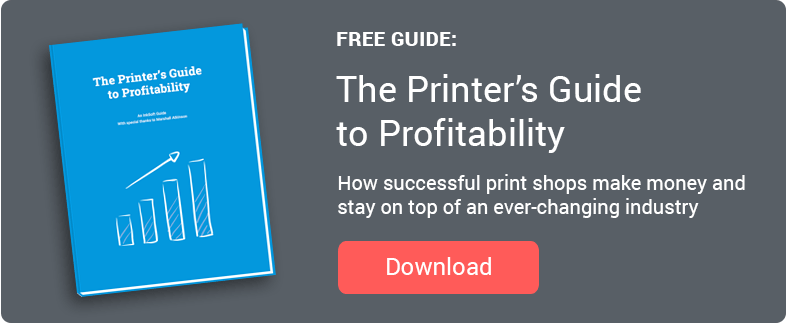When it comes to growing profits, many print shops are quick to look for new ways to bring in more revenue. Unfortunately, but they forget the other half of the equation.
Turning your attention to business costs is a super effective way of raising your profits without a ton of extra effort. Here are five ways to start cutting costs in your print shop immediately.
Editor’s note: This was originally shared in our free e-book “The Printer’s Guide to Profitability.” Check it out!
1) Use your equipment to its fullest potential
What kinds of presses do you use, and how often are they used correctly? For example, are you running that thirty piece, two color job on an automatic because you don’t have anywhere else to put it? An automatic press can print much faster than a manual, but it also uses more labor. It also has a high opportunity cost associated with it””for every manual-sized job you’re running on the auto, that’s one larger job you’re slowing down or missing out on.
In this case, it’s probably time to buy another manual press. However, if your business isn’t in a position to buy, try staffing a second shift. The extra labor will be a more manageable expense, and using your equipment to its fullest potential will save you thousands.
2) Get new insurance quotes
Every once in awhile, it’s useful to put your plan out for bid and see what comes back. This is especially true if your shop has been safety conscious and you have a low DART score. DART stands for “Days Away, Restricted, or Transferred.” The DART rate is an OSHA calculation, which determines how safe your company has been regarding particular types of worker compensation injuries. Lower DART scores could get bigger discounts.
3) Analyze your overtime
How much do you spend on overtime every month? Sometimes, overtime is unavoidable. But if it keeps happening, there may be larger causes at play. For example, maybe there are repeated late jobs, or there have been a few unusually large orders. Maybe there’s a certain client who tends to cause more overtime than your others.
In the short-term, this isn’t a huge concern. However, if a pattern emerges, it’s time to understand exactly why the overtime is happening and how to plan for it better. If it’s not something that can be planned for in your situation, maybe it’s time to talk to the client. Are you expected to eat the cost, or can this be a negotiated element in doing business with them?
4) Start a sustainability program
Sustainability isn’t just an environmental practice””it’s a smart business decision.
Recycling soda cans and cardboard is just the beginning. Take a closer look. There’s probably a better performing consumable on the market that allows you to use less of the product. Maybe there’s some equipment you can buy or a process you can develop in your shop that will eliminate the need for something altogether. The first step is to get your team together and ask “Why do we do it this way?” As you go through every step in the process, it will become clear where you can save time and money.
Next, get creative with your waste. Misprinted or defective apparel can be reused for test prints. Plastic bags that wrap t-shirts in inventory boxes can be reused as trash bags. What else can you repurpose?
A big piece of the puzzle that’s easy to change is your energy consumption. No one wants to be the energy police and walk around telling people to “turn that off,” but it pays to examine how energy is used in your shop and identify a few key changes your team can make to cut it down.
If you want to make an even bigger impact, reach out to your local government. City, state, and federal offices often have programs that can assist you with grant money, low interest loans, and even training on building a sustainability program. For example, there may be grant money available to replace outdated equipment with newer, more efficient technology. Thinking about changing from fluorescent light to LED? You may be able to get help with the cost. Look into chambers of commerce, environmental agencies, and trade associations for this support.
Finally, there are some courses and certifications that you can use to not only learn how to make your business more sustainable, but also communicate that commitment to your customers. SGIA has a program called the Peer to Peer Network, which is an hour long webinar class every other week. After you’ve finished the course, you can qualify to get their Sustainable Green Printing Partnership certification. This kind of certification is a market differentiator.
5) Change the way you buy
Buying in bulk is a fast way to cut costs on items that you buy regularly. What does your order history look like? Take a few minutes to glance over what you’re ordering over and over again. Can you go up a size with your emulsion or inks to get a better deal?
On the flip side, maybe you’re buying too much in bulk, holding onto blanks or consumables for months before they’re used. This could be costly space-wise if your work area is smaller, and of course costly if you can’t get the product moved out. Are there any distributors who have fast shipping to your area? If so, maybe it’s time to be more selective about the products you keep in stock.
Want to cut even more costs?
We cover costs, revenue, and more in our free e-book!



